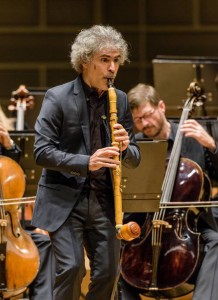So the preface this, I don’t really know that much about music and Mozart, so take everything I say with a grain of salt. I think this might have been my first time (or first time in a very long time) seeing a professional orchestra live, and it was an interesting experience. The orchestra was a smaller group of musicians, and at first, I thought it was a little strange how the basses looked, but I soon realized that many of them were playing historical instruments.
To some extent, the historical instruments matched really well with the individual players. Maybe it was because where we were sitting, but the violins seemed like a natural extension of the violinists. What I liked a lot, was that they were all enjoying playing the music, turning to smile at each other during certain sections and moving and reacting individually to the music. What I found interesting about this, was that the cellos did not have endpins and that the cellists were balancing the instrument with their legs. After a brief search later, I found out that the endpin wasn’t added until the 19th century and that these were really historically accurate.
Speaking of historically accurate instruments, I was surprised to see Lorenzo Coppola walk out with the historical clarinet. I had read the brief blurb about him in the program, but wasn’t aware of how different it would be from the modern clarinet. It was really interesting to see, and I don’t know when I would have been exposed to it otherwise. He introduced the instrument briefly and pointed out that a hole in the back end of could be covered up for an additional note, which Mozart was cognizant of when composing, and that we shouldn’t be surprised if we saw him play it. And thus, for most of his performance, every time he would bend his knees and bring the clarinet down slightly, I was expecting that special note. When he finally did play it, he exaggerated the motion, and the audience was audibly satisfied.
Other part of this performance I wasn’t expecting was the opera pieces. This, I know, is the first time I’ve enjoyed a live opera performance. (My first exposure was an opera in some other language as part of a class field trip in third grade, during which I fell asleep). While the music and Christian Gerhaher’s voice were great to listen to, I couldn’t help myself thinking about how strange the lyrics and the whole premise of an opera is. The translations indicated that a lot of the pieces were about loving women, fighting, or fighting for women, and the certain phrases that were repeated or especially enhanced by the operatic patterns didn’t make sense all of the time, and I just thought about how strange it would be to hear someone singing about these things in English in the same operatic manner.
Overall, I concluded that I should see more live music. Although I know of and have heard some famous composer’s works, I don’t know that much. If you had asked me after just hearing the FBO play, I wouldn’t know off the top of my head that the composer was Mozart. While I definitely recognized some parts of the Clarinet Concerto, I wouldn’t have been able to say that it resembled Die Zauberflöte. I realized that I should probably take the time to learn a little more about classical music, and I’m open to more performances (especially if they involve encores with a mandolin).


